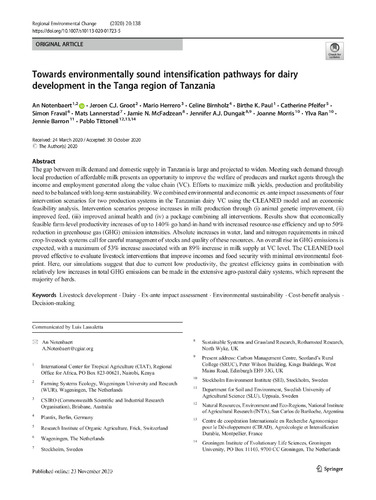Towards environmentally sound intensification pathways for dairy development in the Tanga region of Tanzania
The gap between milk demand and domestic supply in Tanzania is large and projected to widen. Meeting such demand through local production of affordable milk presents an opportunity to improve the welfare of producers and market agents through the income and employment generated along the value chain (VC). Efforts to maximize milk yields, production and profitability need to be balanced with long-termsustainability. We combined environmental and economic ex-ante impact assessments of four intervention scenarios for two production systems in the Tanzanian dairy VC using the CLEANED model and an economic feasibility analysis. Intervention scenarios propose increases in milk production through (i) animal genetic improvement, (ii) improved feed, (iii) improved animal health and (iv) a package combining all interventions. Results show that economically feasible farm-level productivity increases of up to 140% go hand-in-hand with increased resource-use efficiency and up to 50% reduction in greenhouse gas (GHG) emission intensities. Absolute increases in water, land and nitrogen requirements in mixed crop-livestock systems call for careful management of stocks and quality of these resources. An overall rise in GHG emissions is expected, with a maximum of 53% increase associated with an 89% increase in milk supply at VC level. The CLEANED tool proved effective to evaluate livestock interventions that improve incomes and food security with minimal environmental footprint. Here, our simulations suggest that due to current low productivity, the greatest efficiency gains in combination with relatively low increases in total GHG emissions can be made in the extensive agro-pastoral dairy systems, which represent the majority of herds.

